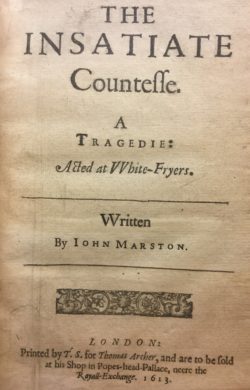<em>The Insatiate Countess</em>
The Insatiate Countess poses an especial challenge in the context of a Complete Works of John Marston, as its authorship has been repeatedly contested. At various points in its early history it has been promoted as the work of Marston and of William Barksted and Lewis Machin. Marston was credited in the first edition of 1613 and the third edition of 1631, but in both cases he appears to have demanded that his name be removed – in the Bodleian Library copy of the first edition it has been physically cut out – and reissued title-pages assigned the play to Barksted and Machin (1613) and Barksted (1631).
Barksted was an actor and poet, the author of two narrative poems Mirrha, The Mother of Adonis (1607) and Hiren, or The Fair Greek (1611), and the first performer to play Morose in Ben Jonson’s Epicene (1609-10). Machin was also a poet, his Eclogues being published with Mirrha. It is usually thought that Barksted and Machin finished the play from an incomplete draft, possibly for the Children of the Queen’s Revels, who performed Epicene, around 1610-13. The large number of corruptions and confusions in the 1613 text include multiple names for many of the characters, which support the idea that a rewrite has taken place.
Fascinating as these questions are, they have often drawn attention away from the fact that The Insatiate Countess is a superb piece of theatre. It is a notable example of Jacobean double plotting, of a kind found also in Shakespeare’s King Lear and Middleton and Rowley’s The Changeling. A tragic plot centres on Isabella, Countess of Swevia, who successively falls in love with a series of noblemen, attempting to rid herself of each when her affections change, and a comic plot focuses on the attempts of two city wives and friends, Abigail and Thais, to stop their feuding husbands from ruining each other. Both plots involve sexual manipulation and obsession, and the play is shot through with a rich vein of bawdy humour that encompasses a double bed-trick, a stage direction that reads ‘Isabella falls in love with Rogero when the changers speak’, and an opening scene in which the Countess is discovered apparently in mourning by a group of gallants, one of whom asks – in the play’s first line – ‘What should we do in this Countess’s dark hole?’
It is perhaps unsurprising that an early nineteenth century editor declared, ‘It is fortunate for Marston’s reputation as a Dramatist, that “The Insatiate Countess” cannot be cited as a fair specimen of his powers’, calling Isabella ‘a truly disgusting wretch’ and Abigail and Thais ‘scarcely better than two strumpets’ (The Insatiate Countess, a Tragi-Comedy, by John Marston , 1820, xi-xii). If we lay aside such censorious judgements, however, the play reveals a combination of theatrical vibrancy, laugh-out-loud humour and a tough-minded exploration of female action and agency. It is notable that – as a later editor, Giorgio Melchiori, remarks, in the Revels edition (1984) – Isabella’s role is ‘one of the longest female speaking parts in the whole of Jacobean drama’: she has 550 lines, whereas the two largest male roles have less than 250 lines. Staged readings and workshops of the play have made a strong case for its potential in a full production, and this edition will seek to explore further its dynamics on stage.

